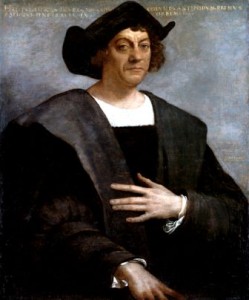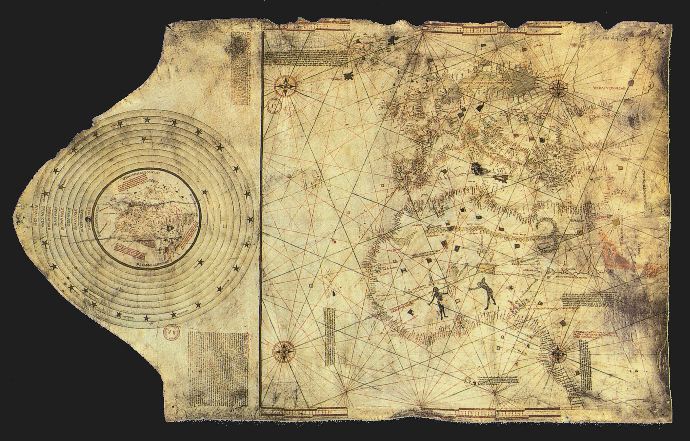Christopher Columbus is an American icon, but how much do you really know about him? Thanks to him many of us get a day off, but it seems few actually know about his accomplishments outside of “discovering America” or know about the atrocities he is accused of committing as governor of the Indies. Here’s a list of 16 common (and not so common) facts about Christopher Columbus. For those interested in reading more about Columbus, most of my research started on the Wikipedia page dedicated to Christopher Columbus.
1. While Columbus played a major role in rooting Europe into North and Central America, he was not the first European to discover America. Leif Ericson landed on the northern tip of Newfoundland almost 500 years earlier. Columbus discovered and explored the Bahamas and other Central American areas (graphic of his trips here). His discoveries were not only five centuries later compared to Ericson, but nowhere near the United States of America that we know today.

2. Columbus’s main goal was to spread Christianity and find gold for the Spanish Empire. Spain’s main goal was to get cash for their costly wars. There really was no honorable goal of discovering a New World.
3. Columbus was actually trying to reach Japan when he landed in the Bahamas.
4. Columbus was rejected three times over seven years (1485 – 1492) before finally getting approval and funds from the Catholic Monarchs Ferdinand and Isabella to make his voyage.
5. Ferdinand and Isabella promised Columbus a large chunk of the profits because they never expected for him to return. The decedents of family sued and levied disputes in court against the crown until 1790.
6. After his first voyage, Columbus was Governor of the Indies, where he did such a bad job and reportedly committed barbaric tortures, that he was arrested and spent 6 weeks in prison. He was freed from prison and took up a his fourth and final voyage to the New World.
7. Against popular belief, Columbus was not the only guy that thought the world was round. Most educated people in Europe understood that the world was not flat. Columbus simply thought the distance to Japan was shorter heading west than east and had no clue there were two continents in the way. It’s as simple as that.
8. Hispaniola’s native Taino population (modern-day Dominican Republic and Haiti) was decimated within 60 years after Columbus visited the island. Due to slavery and European diseases (mainly smallpox) after Columbus’s visit, the Island’s Taino population went from 300,000 to around 500.

9. The New World did have its revenge on Europe. Many scientists believe that syphilis was introduced to Europe when Columbus’s returned home after his first voyage. Once introduced to Europe and spread through traveling armies at war, syphilis caused as many as 5 million European deaths.
10. At the time of his death, most believed that Christopher Columbus died from Gout, but today some experts believe he died from a progressively debilitating form of arthritis, a rare tropical disease.
11. After his death, Columbus’s remains were buried in four different locations; Spain, Dominican Republic, Cuba and back to Spain, mostly due to international politics and war.
12. The asteroid “327 Columbia” was discovered by Auguste Charlois 1892 and named in honor of Columbus.
13. There are 14 commissioned sculptures in the United States dedicated to Christopher Columbus.
14. Columbus’s armchair that he used at his chart table along with other artifacts can be seen at the Columbus family chapel in Boalsburg, Pennsylvania.
15. There are no known authentic portraits of Columbus. All portraits seen today were done posthumous.
16. There are at least 19 locations named after Christopher Columbus to include the country of Columbia, British Columbia in Canada and Washington, D.C. (District of Columbia).
 New Bedford Guide Your Guide to New Bedford and South Coast, MA
New Bedford Guide Your Guide to New Bedford and South Coast, MA









You say, “Columbus’s main goal was to spread Christianity and find gold for the Spanish Empire. Spain’s main goal was to get cash for their costly wars. There really was no honorable goal of discovering a New World.”
Some of us might think that spreading Christianity is an honorable goal. Finding gold and getting cash, not so much. 😉
Colleen, I can see how my point can be a bit confusing. What I meant by my last sentence was that there was no real honorable goal to discover the new world, or it wasn’t even an objective. The main objectives were to spread Christianity and gain wealth. I really don’t have an opinion if spreading Christianity is a good or bad thing. I’ve learned long ago not to get into that debate!
Nice website, I learned something new!
But.. You are wrong on one thing, there was an honorable
goal to find the new world!
Spreading Christianity!
I knew most of this and im in 8th grade!!
Ok let’s see, an Italian, son of a weaver spoke Italian, Portuguese, Latin and Spanish. He swam from a shipwreck to St. michael’s where he married the governor’s daughter and had several audiences with the king of Portugal to convince him of hid idea of traveling west to find the spice islands of the Far East. The king said no. On to Spain where he gets an audience with Ferdinand and Isabella who say after they defeat the Moors. Pablo’s gets punished for not supporting the king and is forced to support Columbus. Other than the Pinzon brothers (captains of the Nina and Pinta), there were very few experienced sailors on board hose ships, but lots of convicts. Columbus : discovery, invasion, encounter. He was a terrorist who destroyed a nation in the name of gold. Though we like to clean the story up with the concept of Christianity, these people raped, pillaged and plundered a continent.